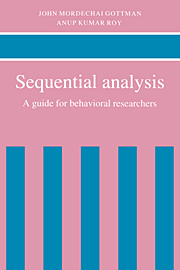Book contents
- Frontmatter
- Contents
- Preface
- Reading this book quickly
- Part I Introduction
- Part II Fitting the timetable
- Part III The timetable and the contextual design
- Chapter 10 Log-linear models
- Chapter 11 Log-linear models: review and examples
- Chapter 12 A single case analysis of the timetable
- Chapter 13 Logit models and logistic regression
- Chapter 14 The problem of autocontingency and its solutions
- Chapter 15 Recent advances: a brief overview
- Chapter 16 A brief summary
- References
- Index
Chapter 14 - The problem of autocontingency and its solutions
from Part III - The timetable and the contextual design
Published online by Cambridge University Press: 10 November 2009
- Frontmatter
- Contents
- Preface
- Reading this book quickly
- Part I Introduction
- Part II Fitting the timetable
- Part III The timetable and the contextual design
- Chapter 10 Log-linear models
- Chapter 11 Log-linear models: review and examples
- Chapter 12 A single case analysis of the timetable
- Chapter 13 Logit models and logistic regression
- Chapter 14 The problem of autocontingency and its solutions
- Chapter 15 Recent advances: a brief overview
- Chapter 16 A brief summary
- References
- Index
Summary
The Problem
This chapter outlines a few approaches to the basic problem of auto-contingency. What is the problem? Briefly, in sequential analysis we want to determine if we can predict the occurrence of code B at time t + 1 by knowing that code A occurred at time t. Usually we have a dyad we are observing, and the B codes come from observing one person's behavior while the A codes come from observing the other person's behavior. The standard we employ to evaluate the prediction is the amount of improvement over the unconditional probability of, p(B). However, there is another standard that makes a lot more sense when we try to establish a causal link between A and B. That standard follows from the fact that knowing that B occurred at time t would lead, in many cases, to gain in prediction over and above the unconditional, p(B). Hence, the test for sequential connection could be made more stringent by comparing p(B| A) not with p(B) but with the residual from p(B) obtained from predicting B's occurrence by own B's past behavior. This could be viewed simply as an adjustment to p(B) in the numerator of our usual z-scores for sequential connection. The nature of this adjustment is the subject of this chapter. Currently, we have little experience with such solutions, and thus our review is entirely theoretical. As we gain experience, we will be able to say more about the relative merits of the alternative reviewed here.
Information
- Type
- Chapter
- Information
- Sequential AnalysisA Guide for Behavorial Researchers, pp. 228 - 239Publisher: Cambridge University PressPrint publication year: 1990
